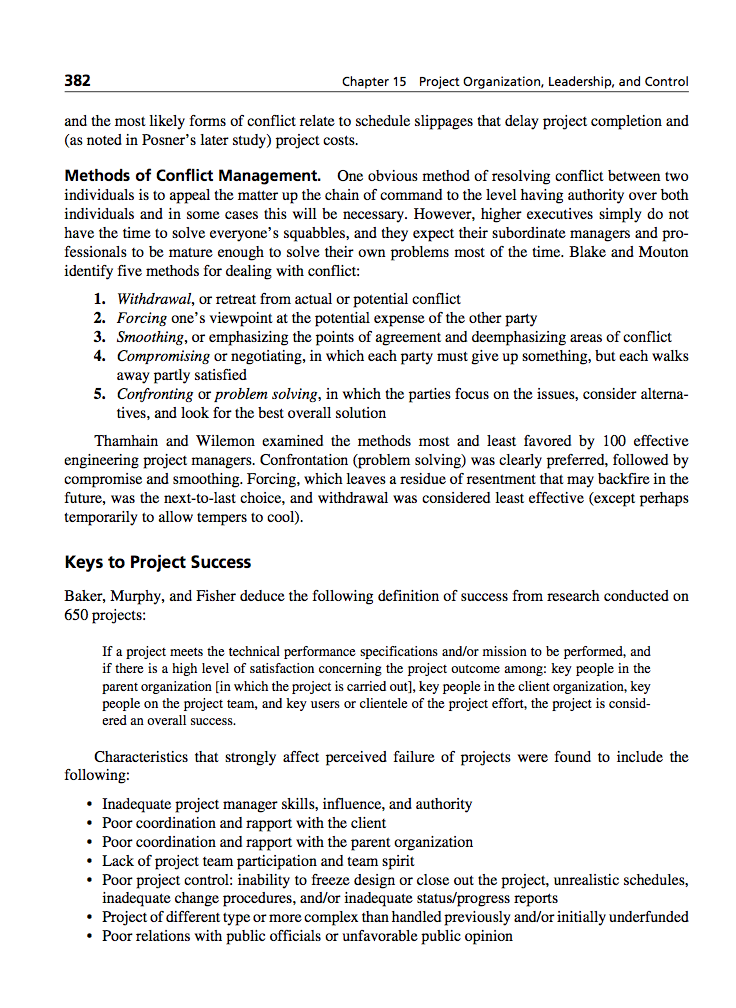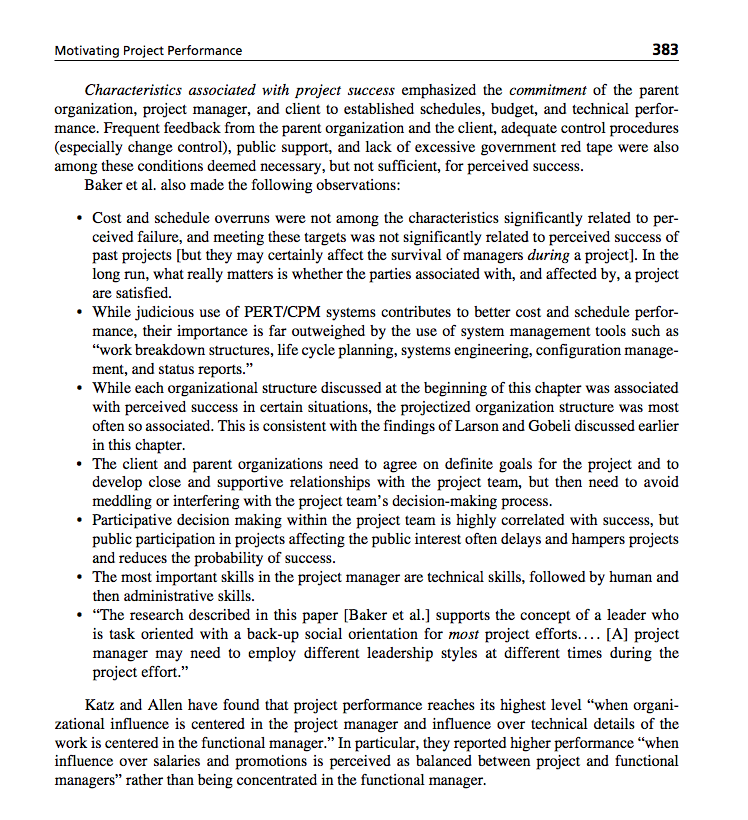Answered step by step
Verified Expert Solution
Question
1 Approved Answer
Consider a situation from a company you are familiar with, where two teams had a conflict when implementing their decisions. What methods were employed to
Consider a situation from a company you are familiar with, where two teams had a conflict when implementing their decisions. What methods were employed to solve the conflicts? Discuss.


Consider a situation from a company you are familiar with, where two teams had a conflict when implementing their decisions. What methods were employed to solve the conflicts? Discuss.
382 Chapter 15 Project Organization, Leadership, and Control and the most likely forms of conflict relate to schedule slip (as noted in Posner's later study) project costs. pages that delay project completion and Methods of Conflict Management. One obvious method of resolving conflict between two individuals is to appeal the matter up the chain of command to the level having authority over both individuals and in some cases this will be have the time to solve everyone's squabbles, and they expect their subordinate managers and pro- fessionals to be mature enough to solve their own problems most of the time. Blake and Mouton identify five methods for dealing with conflict: necessary. However, higher executives simply do not 1. Withdrawal, or retreat from actual or potential conflict 2. Forcing one's viewpoint at the potential expense of the other party 3. Smoothing, or emphasizing the points of agreement and deemphasizing areas of conflict 4. Compromising or negotiating, in which each party must give up something, but each walks away partly satisfied 5. Confronting or problem solving, in which the parties focus on the issues, consider alterna- tives, and look for the best overall solution Thamhain and Wilemon examined the methods most and least favored by 100 effective engineering project managers. Confrontation (problem solving) was clearly preferred, followed by compromise and smoothing. Forcing, which leaves a residue of resentment that may backfire in the future, was the next-to-last choice, and withdrawal was considered least effective (except perhaps temporarily to allow tempers to cool) Keys to Project Success Baker, Murphy, and Fisher de 650 projects duce the following definition of success from research conducted on If a project meets the technical performance specifications and/or mission to be performed, and if there is a high level of satisfaction concerning the project outcome among: key people in the parent organization [in which the project is carried out], key people in the client organization, key people on the project team, and key users or clientele of the project effort, the project is consid- ered an overall success. Characteristics that strongly affect perceived failure of projects were found to include the following: Inadequate project manager skills, influence, and authority Poor coordination and rapport with the client Poor coordination and rapport with the parent organization Lack of project team participation and team spirit .Poor project control: inability to freeze design or close out the project, unrealistic schedules, inadequate change procedures, and/or inadequate status/progress reports .Project of different type or more complex than handled previously and/or initially underfunded . Poor relations with public officials or unfavorable public opinion Motivating Project Performance 383 Characteristics associated with project success emphasized the commitment of the parent organization, project manager, and client to established schedules, budget, and technical perfor mance. Frequent feedback from the parent organization and the client, adequate control procedures (especially change control), public support, and lack of excessive government red tape were also among these conditions deemed necessary, but not sufficient, for perceived success Baker et al. also made the following observations . Cost and schedule overruns were not among the characteristics significantly related to per ceived failure, and meeting these targets was not significantly related to perceived success of past projects [but they may certainly affect the survival of managers during a project]. In the long run, what really matters is whether the parties associated with, and affected by, a project are satisfied. . While judicious use of PERT/CPM systems contributes to better cost and schedule perfor mance, their importance is far outweighed by the use of system management tools such as "work breakdown structures, life cycle planning, systems engineering, configuration manage- ment, and status reports." . While each organizational structure discussed at the beginning of this chapter was associated with perceived success in certain situations, the projectized organization structure was most often so associated. This is consistent with the findings of Larson and Gobeli discussed earlier in this chapter The client and parent organizations need to agree on definite goals for the project and to develop close and supportive relationships with the project team, but then need to avoid meddling or interfering with the project team's decision-making process . Participative decision making within the project team is highly correlated with success, but public participation in projects affecting the public interest often delays and hampers projects and reduces the probability of success The most important skills in the project manager are technical skills, followed by human and then administrative skills. ."The research described in this paper [Baker et al.] supports the concept of a leader who is task oriented with a back-up social orientation for most project efforts.... [A] project manager may need to employ different leadership styles at different times during the project effort." Katz and Allen have found that project performance reaches its highest level "when organi zational influence is centered in the project manager and influence over technical details of the work is centered in the functional manager." In particular, they reported higher performance "when influence over salaries and promotions is perceived as balanced between project and functional managers" rather than being concentrated in the functional manager 382 Chapter 15 Project Organization, Leadership, and Control and the most likely forms of conflict relate to schedule slip (as noted in Posner's later study) project costs. pages that delay project completion and Methods of Conflict Management. One obvious method of resolving conflict between two individuals is to appeal the matter up the chain of command to the level having authority over both individuals and in some cases this will be have the time to solve everyone's squabbles, and they expect their subordinate managers and pro- fessionals to be mature enough to solve their own problems most of the time. Blake and Mouton identify five methods for dealing with conflict: necessary. However, higher executives simply do not 1. Withdrawal, or retreat from actual or potential conflict 2. Forcing one's viewpoint at the potential expense of the other party 3. Smoothing, or emphasizing the points of agreement and deemphasizing areas of conflict 4. Compromising or negotiating, in which each party must give up something, but each walks away partly satisfied 5. Confronting or problem solving, in which the parties focus on the issues, consider alterna- tives, and look for the best overall solution Thamhain and Wilemon examined the methods most and least favored by 100 effective engineering project managers. Confrontation (problem solving) was clearly preferred, followed by compromise and smoothing. Forcing, which leaves a residue of resentment that may backfire in the future, was the next-to-last choice, and withdrawal was considered least effective (except perhaps temporarily to allow tempers to cool) Keys to Project Success Baker, Murphy, and Fisher de 650 projects duce the following definition of success from research conducted on If a project meets the technical performance specifications and/or mission to be performed, and if there is a high level of satisfaction concerning the project outcome among: key people in the parent organization [in which the project is carried out], key people in the client organization, key people on the project team, and key users or clientele of the project effort, the project is consid- ered an overall success. Characteristics that strongly affect perceived failure of projects were found to include the following: Inadequate project manager skills, influence, and authority Poor coordination and rapport with the client Poor coordination and rapport with the parent organization Lack of project team participation and team spirit .Poor project control: inability to freeze design or close out the project, unrealistic schedules, inadequate change procedures, and/or inadequate status/progress reports .Project of different type or more complex than handled previously and/or initially underfunded . Poor relations with public officials or unfavorable public opinion Motivating Project Performance 383 Characteristics associated with project success emphasized the commitment of the parent organization, project manager, and client to established schedules, budget, and technical perfor mance. Frequent feedback from the parent organization and the client, adequate control procedures (especially change control), public support, and lack of excessive government red tape were also among these conditions deemed necessary, but not sufficient, for perceived success Baker et al. also made the following observations . Cost and schedule overruns were not among the characteristics significantly related to per ceived failure, and meeting these targets was not significantly related to perceived success of past projects [but they may certainly affect the survival of managers during a project]. In the long run, what really matters is whether the parties associated with, and affected by, a project are satisfied. . While judicious use of PERT/CPM systems contributes to better cost and schedule perfor mance, their importance is far outweighed by the use of system management tools such as "work breakdown structures, life cycle planning, systems engineering, configuration manage- ment, and status reports." . While each organizational structure discussed at the beginning of this chapter was associated with perceived success in certain situations, the projectized organization structure was most often so associated. This is consistent with the findings of Larson and Gobeli discussed earlier in this chapter The client and parent organizations need to agree on definite goals for the project and to develop close and supportive relationships with the project team, but then need to avoid meddling or interfering with the project team's decision-making process . Participative decision making within the project team is highly correlated with success, but public participation in projects affecting the public interest often delays and hampers projects and reduces the probability of success The most important skills in the project manager are technical skills, followed by human and then administrative skills. ."The research described in this paper [Baker et al.] supports the concept of a leader who is task oriented with a back-up social orientation for most project efforts.... [A] project manager may need to employ different leadership styles at different times during the project effort." Katz and Allen have found that project performance reaches its highest level "when organi zational influence is centered in the project manager and influence over technical details of the work is centered in the functional manager." In particular, they reported higher performance "when influence over salaries and promotions is perceived as balanced between project and functional managers" rather than being concentrated in the functional managerStep by Step Solution
There are 3 Steps involved in it
Step: 1

Get Instant Access to Expert-Tailored Solutions
See step-by-step solutions with expert insights and AI powered tools for academic success
Step: 2

Step: 3

Ace Your Homework with AI
Get the answers you need in no time with our AI-driven, step-by-step assistance
Get Started


